2003 Hyundai Grandeur belt
[x] Cancel search: beltPage 14 of 235

YOUR VEHICLE AT A GLANCE
Turn Signal Indicator Lights ABS Service Reminder Indicator Traction Control Indicator Light Seat Belt Warning LightHigh Beam Indicator Light Trunk Lid Open Warning Light Front Fog Indicator LightLow Oil Pressure Warning LightParking Brake/Low Brake Fluid Level Warning Light Charging System Warning Light Door Ajar Warning Light and Chime Low Fuel Level Warning Light SRS (Airbag) Service Reminder Indicator Cruise Indicator Light Stop/Tail Light Failure Warning Light Malfunction Indicator Light
B255A01L-GAT INDICATOR SYMBOLS ON THE INSTRUMENT PANEL * More detailed explanations of these items will be found beginning on page 1-42
Page 15 of 235

1. FEATURES OF YOUR HYUNDAIFuel Recommendations .................................................................. 1-2
Breaking In Your New Hyundai ...................................................... 1-3
Keys (Immobilizer System) ...................................................... 1-3, 1-4
Door Locks (Theft-Alarm System) ........................................... 1-6, 1-8
Power Windows ............................................................................ 1-10
Seat (Power Seat) ............................................................... 1-11, 1-14
I.M.S (Integrated Memory System) ............................................... 1-16
Seat Belt ....................................................................................... 1-19
Child Restraint System ................................................................. 1-24
Supplemental Restraint (AIRBAG) System .................................. 1-32
Instrument Cluster and Indicator Lights ........................................ 1-40
Warning Light and Indicator ......................................................... 1-42
Multi-function Light Switch ............................................................ 1-49
Windshield Wiper/Washer Switch ................................................. 1-51
Trip Computer ............................................................................... 1-54
Sunroof ......................................................................................... 1-58
Mirror ............................................................................................. 1-63
Hood Release ............................................................................... 1-69
Cruise Control ............................................................................... 1-74
Audio Remote Control Switch ....................................................... 1-76
Heating and Cooling Control ........................................................ 1-78
Stereo Sound System ................................................................... 1-93
Audio System ................................................................................ 1-95
Antenna ...................................................................................... 1-117
1
Page 20 of 235
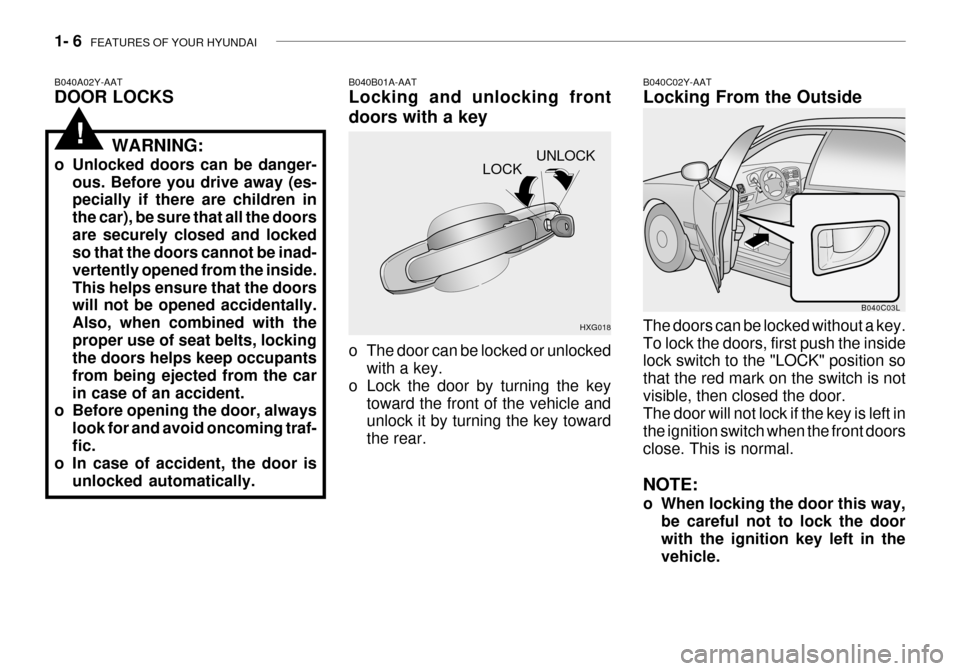
1- 6 FEATURES OF YOUR HYUNDAI
UNLOCK
LOCK
HXG018
B040A02Y-AAT DOOR LOCKS
B040B01A-AATLocking and unlocking front doors with a key
o The door can be locked or unlocked
with a key.
o Lock the door by turning the key
toward the front of the vehicle and unlock it by turning the key toward the rear.
!
B040C03L
B040C02Y-AAT Locking From the Outside The doors can be locked without a key. To lock the doors, first push the inside lock switch to the "LOCK" position so that the red mark on the switch is notvisible, then closed the door. The door will not lock if the key is left in the ignition switch when the front doorsclose. This is normal. NOTE:
o When locking the door this way,
be careful not to lock the door with the ignition key left in the vehicle.
WARNING:
o Unlocked doors can be danger- ous. Before you drive away (es- pecially if there are children in the car), be sure that all the doorsare securely closed and locked so that the doors cannot be inad- vertently opened from the inside.This helps ensure that the doors will not be opened accidentally. Also, when combined with theproper use of seat belts, locking the doors helps keep occupants from being ejected from the carin case of an accident.
o Before opening the door, always
look for and avoid oncoming traf-fic.
o In case of accident, the door is
unlocked automatically.
Page 26 of 235
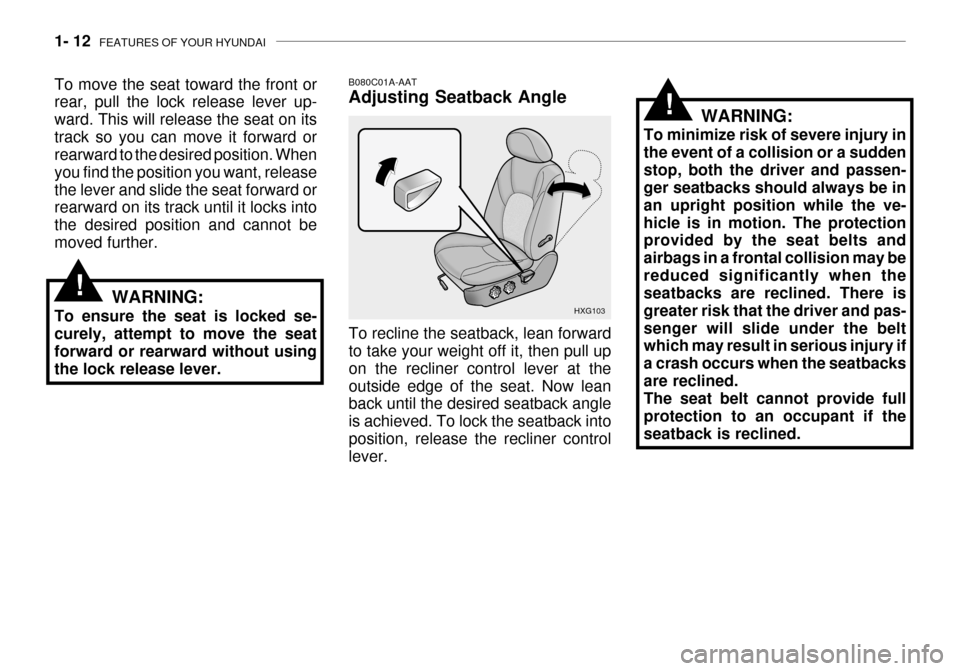
1- 12 FEATURES OF YOUR HYUNDAI
To move the seat toward the front or rear, pull the lock release lever up- ward. This will release the seat on itstrack so you can move it forward or rearward to the desired position. When you find the position you want, releasethe lever and slide the seat forward or rearward on its track until it locks into the desired position and cannot bemoved further.
HXG103
B080C01A-AAT Adjusting Seatback Angle
To recline the seatback, lean forward to take your weight off it, then pull up on the recliner control lever at theoutside edge of the seat. Now lean back until the desired seatback angle is achieved. To lock the seatback intoposition, release the recliner control lever. WARNING:
To minimize risk of severe injury in the event of a collision or a suddenstop, both the driver and passen- ger seatbacks should always be in an upright position while the ve-hicle is in motion. The protection provided by the seat belts and airbags in a frontal collision may bereduced significantly when the seatbacks are reclined. There is greater risk that the driver and pas-senger will slide under the belt which may result in serious injury if a crash occurs when the seatbacksare reclined. The seat belt cannot provide full protection to an occupant if theseatback is reclined.
!
WARNING:
To ensure the seat is locked se- curely, attempt to move the seat forward or rearward without usingthe lock release lever.!
Page 29 of 235
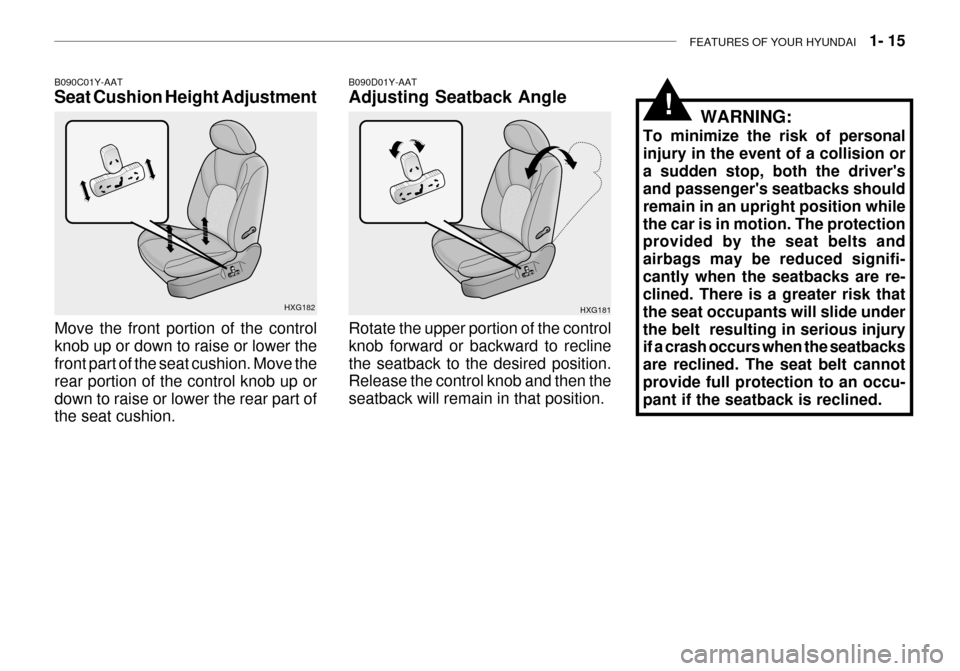
FEATURES OF YOUR HYUNDAI 1- 15
HXG181
B090D01Y-AAT Adjusting Seatback Angle
Rotate the upper portion of the control knob forward or backward to recline the seatback to the desired position. Release the control knob and then the seatback will remain in that position. WARNING:
To minimize the risk of personalinjury in the event of a collision ora sudden stop, both the driver's and passenger's seatbacks should remain in an upright position whilethe car is in motion. The protection provided by the seat belts and airbags may be reduced signifi-cantly when the seatbacks are re- clined. There is a greater risk that the seat occupants will slide underthe belt resulting in serious injury if a crash occurs when the seatbacks are reclined. The seat belt cannot provide full protection to an occu- pant if the seatback is reclined.
!
B090C01Y-AAT Seat Cushion Height Adjustment
Move the front portion of the control knob up or down to raise or lower the front part of the seat cushion. Move the rear portion of the control knob up ordown to raise or lower the rear part of the seat cushion. HXG182
Page 32 of 235
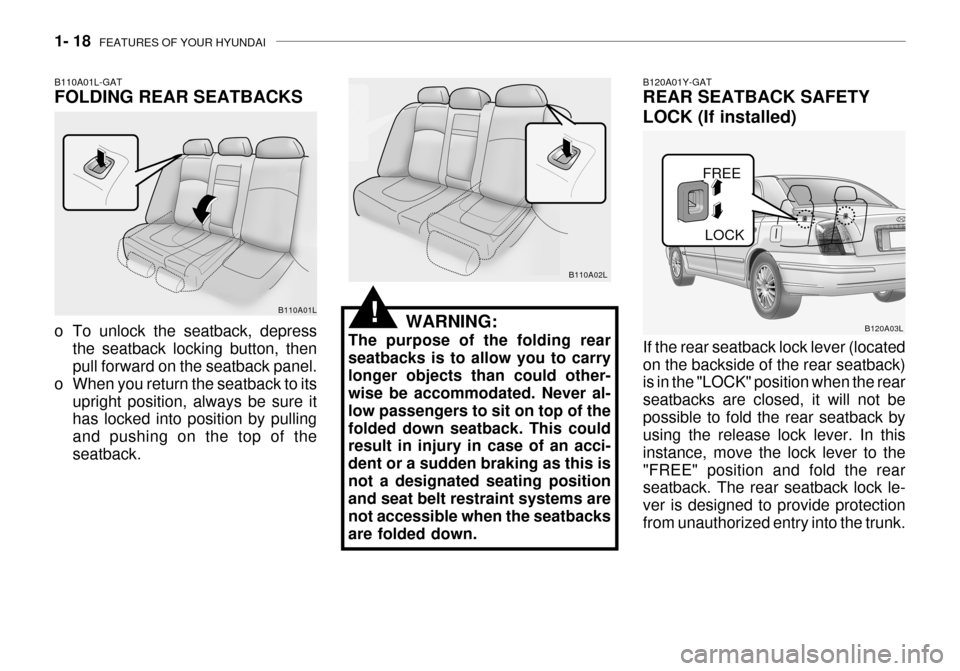
1- 18 FEATURES OF YOUR HYUNDAI
FREE
LOCK
B120A01Y-GAT REAR SEATBACK SAFETY LOCK (If installed) If the rear seatback lock lever (located on the backside of the rear seatback) is in the "LOCK" position when the rear seatbacks are closed, it will not bepossible to fold the rear seatback by using the release lock lever. In this instance, move the lock lever to the"FREE" position and fold the rear seatback. The rear seatback lock le- ver is designed to provide protectionfrom unauthorized entry into the trunk. B120A03L
WARNING:
The purpose of the folding rear seatbacks is to allow you to carrylonger objects than could other- wise be accommodated. Never al- low passengers to sit on top of thefolded down seatback. This could result in injury in case of an acci- dent or a sudden braking as this isnot a designated seating position and seat belt restraint systems are not accessible when the seatbacksare folded down. B110A02L!B110A01L
B110A01L-GAT FOLDING REAR SEATBACKS
o To unlock the seatback, depress
the seatback locking button, then pull forward on the seatback panel.
o When you return the seatback to its
upright position, always be sure ithas locked into position by pulling and pushing on the top of theseatback.
Page 33 of 235

FEATURES OF YOUR HYUNDAI 1- 19
B150D01A-AAT Pregnant Women The use of a seat belt is recommended for pregnant women to lessen thechance of injury in an accident. When a seat belt is used, the lap belt portion should be placed as low and snugly aspossible on the hips, not across the abdomen. For specific recommenda- tions, consult a physician.
B150C02A-AAT Larger Children Children who are too large for child restraint systems should always oc-cupy the rear seat and use the avail- able lap/shoulder belts. The lap por- tion should be fastened snug on thehips and as low as possible. Check belt fit periodically. A child's squirming could put the belt out of position. Chil-dren are afforded the most safety in the event of an accident when they are restrained by a proper restraint sys-tem in the rear seat. If a larger child (over age 13) must be seated in the front seat, the child should be securelyrestrained by the available lap/shoul- der belt and the seat should be placed in the rear most position. Children un-der the age of 13 should be restrained securely in the rear seat. NEVER place a child under the age of 13 in the frontseat. NEVER place a rear facing child seat in the front seat of a vehicle.
B150F01A-AAT One Person Per Belt Two people (including children) should never attempt to use a single seat belt. This could increase the severity of injuries in case of an accident.
B150E01A-AAT Injured Person A seat belt should be used when an injured person is being transported. When this is necessary, you shouldconsult a physician for recommenda- tions.
B150B01Y-GAT Infant or Small Child Some countries require the use of child restraint systems for infants andsmall children. Whether this is required by law or not, it is strongly recom- mended that a child restraint seat orinfant restraint system be used for infants or small children weighing less than 18 kilograms (40 pounds). NOTE: Small children are best protected in an accident when properly re- strained by a child restraint sys-tem.
B150A02A-GAT SEAT BELT PRECAUTIONS All occupants of the vehicle should wear their seat belts at all times. In-deed, your province's laws may re- quire that some or all occupants of the vehicle use seat belts.The possibility of injury or the severity of injury in an accident will be de- creased if this elementary safety pre-caution is observed. In addition, the following recommendations are made:
Page 34 of 235
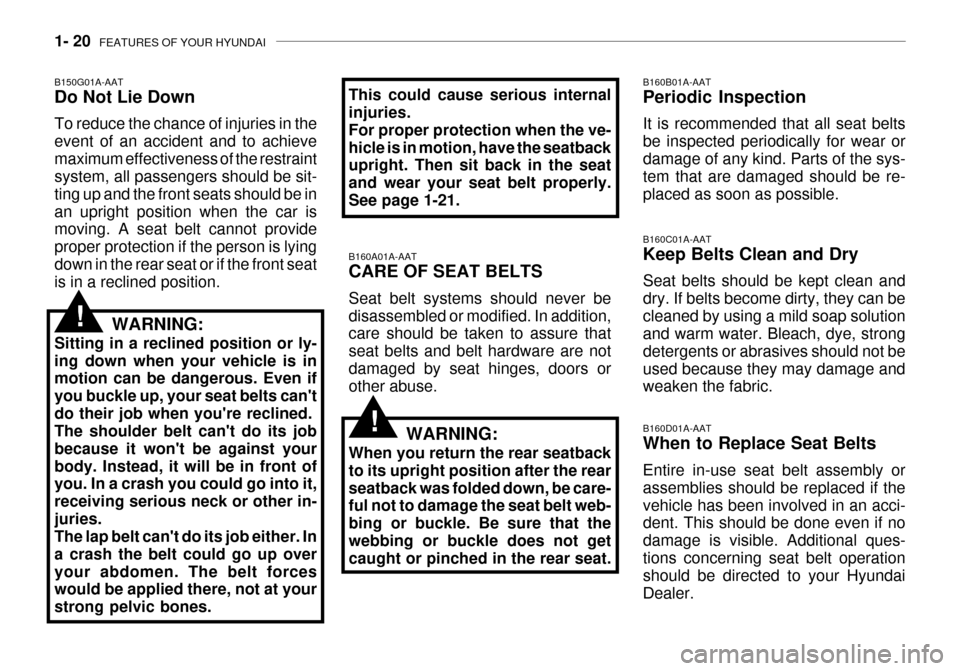
1- 20 FEATURES OF YOUR HYUNDAI
B160C01A-AAT Keep Belts Clean and Dry Seat belts should be kept clean and dry. If belts become dirty, they can becleaned by using a mild soap solution and warm water. Bleach, dye, strong detergents or abrasives should not beused because they may damage and weaken the fabric. B160D01A-AAT When to Replace Seat Belts Entire in-use seat belt assembly or assemblies should be replaced if thevehicle has been involved in an acci- dent. This should be done even if no damage is visible. Additional ques-tions concerning seat belt operation should be directed to your Hyundai Dealer.
B160A01A-AAT CARE OF SEAT BELTS Seat belt systems should never be disassembled or modified. In addition, care should be taken to assure that seat belts and belt hardware are not damaged by seat hinges, doors or other abuse.
This could cause serious internal injuries. For proper protection when the ve-hicle is in motion, have the seatback upright. Then sit back in the seat and wear your seat belt properly.See page 1-21.
B160B01A-AAT Periodic Inspection It is recommended that all seat belts be inspected periodically for wear ordamage of any kind. Parts of the sys- tem that are damaged should be re- placed as soon as possible.
WARNING:
When you return the rear seatback to its upright position after the rearseatback was folded down, be care- ful not to damage the seat belt web- bing or buckle. Be sure that thewebbing or buckle does not get caught or pinched in the rear seat.!
B150G01A-AAT Do Not Lie Down To reduce the chance of injuries in the event of an accident and to achievemaximum effectiveness of the restraint system, all passengers should be sit- ting up and the front seats should be inan upright position when the car is moving. A seat belt cannot provide proper protection if the person is lyingdown in the rear seat or if the front seat is in a reclined position.
WARNING:
Sitting in a reclined position or ly- ing down when your vehicle is in motion can be dangerous. Even if you buckle up, your seat belts can'tdo their job when you're reclined. The shoulder belt can't do its job because it won't be against yourbody. Instead, it will be in front of you. In a crash you could go into it, receiving serious neck or other in-juries. The lap belt can't do its job either. In a crash the belt could go up overyour abdomen. The belt forces would be applied there, not at your strong pelvic bones.
!